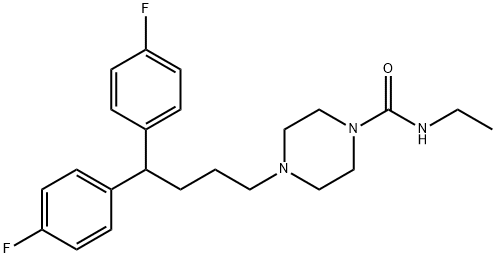Manufacturing Process
(1). A stirred mixture of 4.7 g (0.03 mole) of N'-ethyl-1-
piperazinecarboxamide, 10.1 g (0.036 mole) of 4-chloro-1,1-(di-pfluorophenyl)
butane, 5.0 g of sodium bicarbonate and 10 ml of ethanol was
heated at reflux for 60 hours. 50 ml of water was added. The mixture was
extracted twice with ether. The combined extracts were dried over sodium
sulfate and concentrated. The residue was dissolved in ethanol-ether and the
hydrochloride was precipitated with hydrogen chloride in ethanol. The solid
was collected by filtration and recrystallised from 2-butanone-isopropanol 4:1
to give 6.4 g of N'-ethyl-4-[4,4-(di-p-fluorophenyl)butyl]-1-
piperazinecarboxamide hydrochloride. Melting point 177-178°C.
(2). A stirred mixture of 9.9 g (0.03 mole) of 1-[4,4-(di-pfluorophenyl)
butyl]piperazine, 5,0 g (0,03 mole) of phenyl N-ethylcarbamate,
6,6 g of potassium carbonate and 100 ml of toluene was heated at reflux for
45 minutes. The mixture was filtered and the solvent was removed. The
residual oil was dissolved in ethanol-ether and the hydrochloride was
precipitated with hydrogen chloride in ethanol. The solid was collected by
filtration and recrystallized from 2-butanone-isopropanol 4:1 to give 6.8 g of
N'-ethyl-4-[4,4-(di-p-fluorophenyl)butyl]-1-piperazinecarboxamide
hydrochloride. Melting point 177-178°C.

